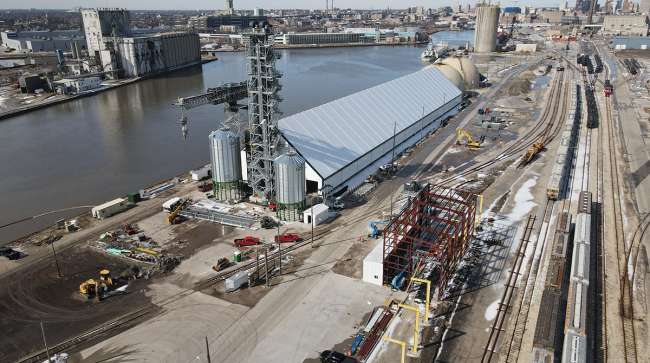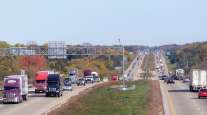Staff Reporter
Trucking Critical to Port of Milwaukee’s New Export Facility

[Stay on top of transportation news: Get TTNews in your inbox.]
The Port of Milwaukee’s new $40 million agricultural maritime export facility not only marks its largest cash infusion since the 1950s, but also will open doors to more overseas markets using its multimodal infrastructure.
“Trucking will be a critical component in the transport of Wisconsin-grown agricultural products from regional farmers, growers and producers to markets around the globe,” Jackie Carter, port director, told Transport Topics.
Operations are slated to begin in May at the new DeLong Co. Inc. Agricultural Maritime Export Facility being built on 3.9 acres along the inner harbor on Jones Island in Milwaukee. It represents the largest one-time investment in the port since the 1950s when the St. Lawrence Seaway was built.
“Port Milwaukee is an integral link in the Wisconsin economy. In this case, we are connecting Wisconsin farmers, growers and producers with new international markets,” Carter said. “The development of this facility at Port Milwaukee is a great addition to the city’s marine commerce, and I’m excited to witness the benefits it will create for our maritime economy.”
The facility will number among the first on the Great Lakes St. Lawrence Seaway system to handle various agricultural commodities via truck, rail and international vessel including dried distillers grains with solubles (an animal feed supplement).
It will also handle exports of Wisconsin-grown soybeans, corn and grain. The storage capacity will be 45,000 metric tons (1.7 million bushels). According to state estimates, the new port facility will generate $63 million in new funding yearly to the Wisconsin’s economy and raise the port’s exports by up to 400,000 metric tons per year.

Carter
Transload facilities will include rail and truck gravity dump hoppers connected to a conveyance system to transport the material into a new fabric building. Redevelopment of the site has included demolishing aged and underutilized structures as well as building upgraded mooring infrastructure.
Multiple parties contributed to the overall cost. The U.S. Department of Transportation contributed the lion’s share with $15.89 million in port infrastructure development funds, followed by the Wisconsin Department of Transportation’s Harbor Assistance Program funds for three consecutive years. The state granted $3.38 million last year, $1.25 million in 2021 and $4.9 million in 2020.
“The combined support from local, state and federal officials affirms the importance of this new asset on Jones Island,” Carter noted.
Additionally, Port Milwaukee kicked in $5.7 million as did the DeLong Co. Inc. with $8.88 million, plus being honored by lending its name to the new facility.
Want more news? Listen to today's daily briefing above or go here for more info
“We want to thank the city of Milwaukee for their partnership on this project. We look forward to becoming part of the community,” said Bo DeLong, grain vice president at DeLong Co.
By 2040, Wisconsin is expected to move 1 billion tons of freight (growth of 74% in tonnage across all transportation modes) valued at nearly $1.5 trillion, according to a 2022 update of the state’s freight plan.
According to WisDOT, the commercially navigable waterways that surround Wisconsin on three sides are underutilized for moving freight due to a lack of intermodal connections and type of traditional commodities transported.


